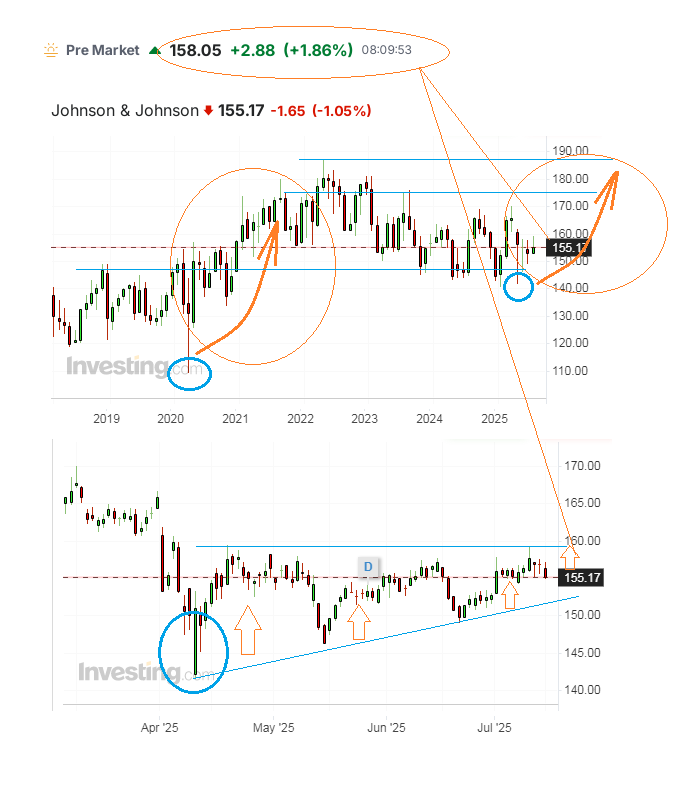Johnson & Johnson (NYSE)
- By date
- Metadoro first
Johnson & Johnson (JNJ) stock, which has been mostly consolidating for a little less than two years, all of a sudden got a rather promising future. The company substantially raised its annual sales guidance despite all those tariff-driven headwinds for the industry. The firm announced on July 16 that it now expects to post its revenue number within the higher range of $93.2 billion to $93.6 billion, up from its own previous estimate of $91 billion to $91.8 billion. So, even the conservative projection is higher than the previous optimistic one. This sounds amazing for the company, which is well known as a specialist in such a conservative segment as daily consumer healthcare goods, with also a diversified portfolio in pharmaceuticals and medical devices.
As to the quarterly routine, Johnson & Johnson also said its Q2 sales rose by 5.8% versus the same three-month period a year before to reach $23.74 billion vs analyst consensus of $22.84 billion, finding out an almost extra one billion of US Dollars somewhere, with Q2 EPS (earnings per share) of $2.77 to top forecast estimates of $2.68 as well. It now expects to add another billion or two in the remaining six months of the year. A much bigger lead in the score than I personally would have expected to see! Given that J&J shares have only gained about 2% to the $158+ area so far in pre-market trading today, I'm looking to grab them right now, expecting a retest of the $170 to $180 range over time, perhaps with such good inputs.
What's the way they do it, right? Its CEO Joseph Wolk cited demand fuelled by Darzalex blood cancer therapy, which showed better-than-projected sales of $3.54 billion. J&J also gave hope for some "game-changing approvals and submissions anticipated in areas like lung and bladder cancer, major depressive disorder, psoriasis, surgery and cardiovascular". Joseph Wolk also gave a comment on the tariff issue. Compared to his previous saying, based on the information available at the launch of Trump's tariff threats, that he anticipated a $400 million impact, now in the wake of a framework trade truce between the US and China, the hit is "probably" down to $200 million. Sounds like nothing more painful than a mosquito bite to such a giant seller. President Trump is going to unveil levies on pharmaceuticals likely by the end of July or early August, beginning with what he has once described as a "low tariff rate" to give businesses enough time to shift their manufacturing operations to the US territory. But he added that a "very high tariff" will then be into effect "in a year or so". That's why it's surely too early to forecast the company's prospect concerning 2026 results, but it's going to be fine for the rest of 2025.
They claim that they have calculated everything properly, even despite Stelara biosimilar competition. Stelara is a biologic medication designed for moderate to severe plaque psoriasis, active psoriatic arthritis, Crohn's disease and ulcerative colitis. It basically works by targeting proteins in the immune system that cause inflammation. But what's important from the financial point of view that Stelara was made by Janssen Biotech, Inc., a subsidiary of Johnson & Johnson, so that Johnson & Johnson is the original manufacturer and marketer of Stelara, but there are now rather newly baked biosimilar versions available, made by Teva, Alvotech and Amgen. Those versions have also received US regulatory approval, clearly competing in sales with J&J's original medication.
While all this is happening, the company's inner forecasts have increased, and they also promised nice dividend numbers of $1.30 per share each quarter. Next time when the dividend will be payable is on September 9, 2025, to all stockholders of record on August 26. Those dividends are based on a 3.4% annual rate, and of course are far from the major argument when buying an asset or not, but I would not mind receiving them for a couple of quarters, if the asset itself also grows in price by some digits. This can't be compared with my return from AI investment, of course, but could be very interesting for the conservative part of my portfolio, instead of just cash or low-yield public bonds which I consider as a waste of money. Back to JNJ, monthly charts show that a multi-year support around $140 has been tested quickly but properly in early April during the overall tariff correction of Wall Street, the risk of losing something does not look significant, but a repeat of the 2020-2021 mini-rally for J&J looks like the baseline scenario.

Johnson & Johnson (NYSE)
| Ticker | JNJ |
| Contract value | 100 shares |
| Maximum leverage | 1:5 |
| Date | Short Swap (%) | Long Swap (%) | No data |
|---|
| Minimum transaction volume | 0.01 lot |
| Maximum transaction volume | 100 lots |
| Hedging margin | 50% |
| USD Exposure | Max Leverage Applied | Floating Margin |
|---|









